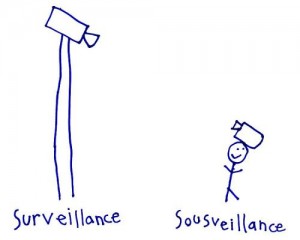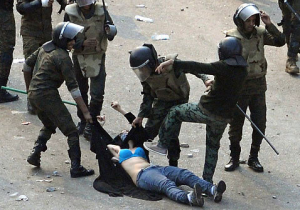At the moment I conduct the finishing touches of a text on Syria and the role of citizen-journalism and online-video broadcasting through mobile communications. Leaving the detailed description and analysis to the forthcoming publication, I am struggling to decide whether or not to enter, hence adding to the publication, a discussion on surveillance vs. sousveillance; the attempt for social control by governments vs. citizens use of same technology to observe and control its governments (from a grassroots perspective). The neologism of sousveillance was coined by Steve Mann, a pioneer in wearable computing at the University of Toronto. In the 1990’s he rigged a head-mounted camera to broadcast images online and found that it was great for documenting everyday malfeasance, like electrical-code violations. He also discovered that it made security guards uneasy. They’d ask him to remove the camera and when he refused they’d escort him away or simply tackle him.
The perhaps most famous example of this feature could be when Los Angeles resident George Holliday videotaped police officers assaulting Rodney King in 1991, after being stopped for a traffic violation. From the voyeuristic images a debate on police brutality emerged and the officers were put on trial. The example manifests an unplanned sousveillance, opposite to in for example the Arab Spring abd Syria in which the strategic use of capturing regimes’ abuse of its populations. In this latter case the technology is primarily used by citizens through a conscious implementation in real time often with specific purposes.
But the purposes aside, the current society being balanced between sur- and sousveillance technology is no longer a utopian vision but an implemented reality. Since the attempts from regimes in Egypt, Syria and other Arab countries to control the technology and integrate the same technology that has empowered citizens to resist and mobilize protests in their own operations, contemporary society must be considered technocratic in the sense that control and strategic use of technology during these circumstances is extremely important feature for stakeholders on both sides. The struggle over information control has been going on for a long time but currently we are witnessing how contextual power balances have been evened out, much due to the technological design and innovation supporting democracy, citizens and free speech.
The implications of this feature is often described as liberating, fair and democratic. However when analytically proceeding towards the long-term macro sociological implications, the perspective becomes more troubling. The social control of surveillance by goverments over citizens, mainly illustrated in totalitarian regimes, has thoughout history resulted in a sense of fear. Jeremy Bentham’s (1838) historical consideration of the ‘panopticon’ and a social system where the monitoring and observation made people aware of the fact that they might be monitored, although didn’t know. This impact was found, according to Michel Foucault in writings from the 1980’s, to implicate that the monitoring through both symbolic and pragmatic use of the panopticon within a specific social context (such as a prison) could influence people to think and act in a certain way based on the fear that they could be monitored, thus given rise to opportunities for social control. The panopticon was part of the industrial revolution that embraced a need for industrial monitoring where owners and other people in power could monitor public places just prisons and factories.
So given this sense of fear, isn’t it also natural to consider the risks/desperation/actions of governments when the situation is no longer one-, but two-way monitoring? It is this particular consequence I find highly interesting in this matter: what are the implications of governing when sousveillance features, the alteration of social control, spreads? To my knowledge this is by far a question that is largely unanswered. We are starting to see attempts from goverments to resume control, to resume former domination and legimitizing it through rhetorics of “safety” and “security”. But in order to grasp a deeper macro-perspective on this recent development, the stated question should be regarded in several intellectual levels/disciplines as well as in processes of engineering, production, distribution and use of technology.
And as I write this I realize that would be a case of double standards if not to emphasize this in my text. Hence, back to work.
If anyone know of vital references to this overall theme, feel free to share your thoughts with me at michael.krona@mah.se





